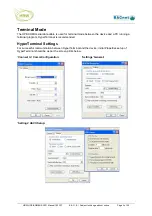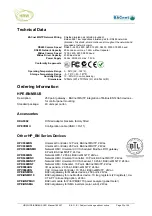
HRW HPE-BNMBUS V401 Manual 180307 E. & O. E. / Subject to change without notice
Page 15 of 24
Note: In all cases where it is possible to define only the DIF we recommend that if you have the VIF
information then it should also be defined to ensure the integrity of the data search.
Extension Point (X)
Data Extension points are only required if the preceding data point’s read value contains more than 4
bytes of data. Each X point gives an extra 4 bytes of data capacity.
A data point which includes information that it has 32 bits of data (4 bytes) does not require an X point.
A data point with more than 32 bits, say 64 bits will require one X point to follow the related D data
point.
As a hypothetical example, assume the energy data has 6 bytes of data (1 X data point needed) and
the volume data has 10 bytes (2 X data points needed):
DVIF=4,6,0,0
4=FF,FF,F3,21,MT
5=
0
,
0
,
0
,
0
,XT
6=4,0,0,0,DT
7=
0
,
0
,
0
,
0
,XT
8=
0
,
0
,
0
,
0
,XT
Only AV4 (energy) and AV6 (volume) need be read by the BMS as the gateway will automatically
calculate the final data point values including the related X point values.
Time Scanned Point (T)
The end Code T sets that the point will be scanned every
n
minutes as set with TS= (Time Scan
period).
The time scan period is particularly important when networking battery powered M-Bus devices which
may require that they are read no more than once per day so as to conserve their battery life. In the
case of once per day reading then TS=1440 (minutes).
In any case we recommend to use the T (time scan) configuration, setting the TS period to allow 15
seconds per meter; if four meters then set TS=1 (minute). If 10 meters then set TS=3, and so on.
























